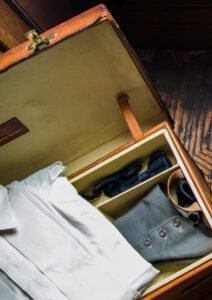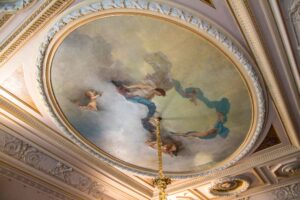
“The houses of the rich are the museums of the poor.”
– Edith Wharton
Towering like an anachronism amid Norwalk, Connecticut’s concrete sprawl, the Lockwood-Mathews Mansion is part palace, part provocation. Built in 1868 by financier LeGrand Lockwood during the height of America’s Gilded Age, this 62-room estate wasn’t just a home—it was a declaration. A $1.3 million statement in stone, wood, and gilded ornamentation that shouted: I have arrived. But whose backs built that arrival? And what’s the real cost of admiring such opulence today?
At once awe-inspiring and morally unsettling, the mansion is an artifact of contradictions. It dazzles with its innovation and beauty while unflinchingly reminding us of the exploitative foundations upon which it rose. As debates around historical memory intensify nationwide, this granite behemoth has become more than a museum—it’s a battleground for America’s reckoning with wealth, labor, race, and preservation.
Monument to Ambition: LeGrand Lockwood and the Birth of a Palace
LeGrand Lockwood wasn’t born into aristocracy. He clawed his way up from modest beginnings to become a titan of finance during the Civil War, cashing in on government bonds, railroads, and the chaos of national conflict. While thousands bled at Antietam and Gettysburg, Lockwood banked staggering profits.
In 1864, with money flowing freely, Lockwood purchased 30 acres in South Norwalk and hired architect Detlef Lienau—a German-born master of the Second Empire style—to design what would become one of the first truly “modern” mansions in the United States. Construction took four years, dozens of artisans, and the latest engineering breakthroughs to complete. The result? A domestic cathedral of wealth that rivaled European royal estates.
A Home Built Like a Machine
Lockwood’s mansion wasn’t just luxurious; it was technological. Among its then-radical features:
- Central Heating: A coal-fired boiler distributed warm air through hidden ducts—a rarity in homes of the time.
- Gas Lighting: Illuminated chandeliers in every major room, using piped gas from an on-site plant.
- Ventilation System: Air could circulate through wall vents connected to attic exhausts, an early precursor to modern HVAC.
- Speaking Tubes: Brass tubes allowed servants and owners to communicate across floors before the age of the intercom.
- Hydraulic Elevator: Though now gone, this early lift system foreshadowed the vertical ambitions of American architecture.
An Interior to Stun and Seduce
The interiors were a symphony of European haute:
- French Marble Fireplaces in nearly every room
- Italian Frescoes hand-painted on ballroom ceilings
- English Oak Paneling imported and hand-carved on-site
- Parquet Floors with intricate inlays of rare hardwoods from around the globe
At its center stood the elliptical rotunda beneath a stained-glass skylight. Designed to frame Lockwood’s personal art collection—including paintings by Albert Bierstadt and Frederic Edwin Church—it created a kaleidoscopic effect in daylight. Visitors described it as “walking into a dream made solid.”
But dreams are fragile.
Collapse and Decay: From Power to Penury
Lockwood finished his mansion just in time for the financial bottom to fall out. The Panic of 1873—a brutal economic crash triggered by speculative overreach and railroad corruption—ravaged his empire. In a matter of months, the man who had once rivaled J.P. Morgan in wealth was broke.
Forced to auction his possessions, Lockwood watched as his treasures fetched pennies on the dollar:
- A $10,000 Steinway sold for $300
- Paintings were liquidated to satisfy creditors
- Furniture, tapestries, and statuary scattered into private collections
He died in 1878, not in splendor but in disgrace. The mansion became a burden no one wanted. Over the following decades, it passed through multiple owners, each struggling to maintain its scale and eccentricity.
By the 1950s, as America embraced highways and suburbs, the mansion stood in the way of “progress.” Planners slated it for demolition to make room for the new Route 7 connector. The dream was nearly erased.
Preservation: Resistance, Revival, and Reinterpretation
History often hinges on a few stubborn individuals. In the case of the Lockwood-Mathews Mansion, it was a group of local historians and activists who, in the 1960s, refused to let it fall. Some literally chained themselves to columns to block demolition equipment.
From Hollywood to the National Register
The mansion’s baroque grandeur attracted location scouts for films like The Stepford Wives (1975), which cemented its gothic allure in popular culture. But real legitimacy came in 1971 when the mansion was named a National Historic Landmark.
Today, it operates as a public museum supported by volunteers, grants, and ticket sales. Key exhibits include:
- Reconstructed Victorian kitchen, complete with ice-cooled food storage closets
- Mechanical banks and penny toys, showcasing the era’s obsession with domestic gadgets
- Restored wall stenciling, recreated from historical photos and fragments beneath layers of paint
Docents speak of “time travel,” but this isn’t a fairy tale. The mansion’s survival is the result of relentless advocacy and an evolving understanding of what, and who, history remembers.
Aesthetic Splendor, Ethical Backdrops
While the Lockwood-Mathews Mansion is undoubtedly a triumph of architecture and preservation, it’s also a mirror reflecting some of the darkest contradictions of American capitalism.
War Profiteering and Dirty Money
Lockwood’s fortune—like that of many Gilded Age magnates—was largely built on government contracts during wartime. While there’s no direct evidence of corruption, the sheer scale of profit during a period of national suffering is hard to ignore. Scholars now examine Lockwood not just as a financier but as a beneficiary of systemic inequality. Who paid for his luxury? Soldiers, taxpayers, and underpaid laborers.
Labor and Exploitation
Accounts suggest that the Italian woodworkers who carved the interior worked 12- to 14-hour days, six days a week, under grueling conditions. Paid far less than their American counterparts, many lived in on-site shanties or cheap boarding houses. The mansion they built was not theirs to enjoy—it was a monument to someone else’s glory.
Urban Displacement and Redlining
Ironically, the same infrastructure that once threatened the mansion—mid-century highways—now isolates it. Hemmed in by on-ramps and concrete walls, the estate stands disconnected from the neighborhoods it once lorded over. This isolation wasn’t accidental. Many highway projects of the 1950s and ’60s were routed through low-income and minority neighborhoods, erasing communities to make way for suburban commuters. The mansion’s continued existence, while commendable, is also a reminder of what was lost around it.
What Do We Preserve—and Why?
This is the central question every visitor must confront. Should we admire the artistry and ignore the ethics? Can we honor the craftsmanship while critiquing the context?
Preservationists argue that sites like Lockwood-Mathews are critical teaching tools. They let us touch history, yes—but more importantly, they force us to wrestle with it. In a time when cultural heritage is politicized and school curriculums contested, the mansion offers a tangible point of entry into complex conversations.
Its chandeliers glitter, but so do its contradictions.
Impressive
The Lockwood-Mathews Mansion is not just an artifact. It’s an ongoing negotiation between memory and morality, between architecture and accountability. It stands because people fought for it. It stands because it dazzles. And it stands because it forces us to ask hard questions.
What does it mean to build a home on the back of war and labor? What should be saved from history, and who decides? Can beauty ever be separated from the brutality that made it possible?
As you exit through its massive oak doors and return to the roar of nearby traffic, the mansion lingers—not just as a marvel of marble and wood, but as a provocation.
The past is never just the past. At Lockwood-Mathews, it’s a living question dressed in silk and stone.
No comments yet.








